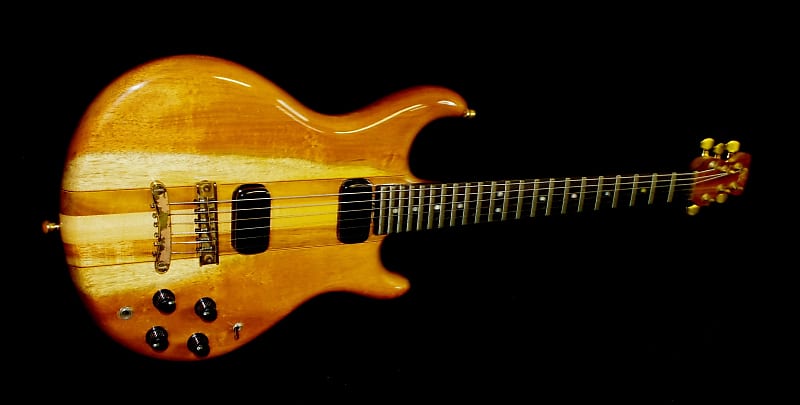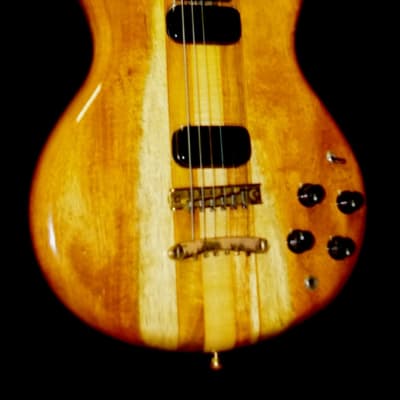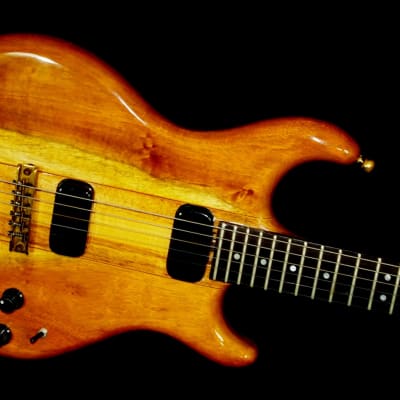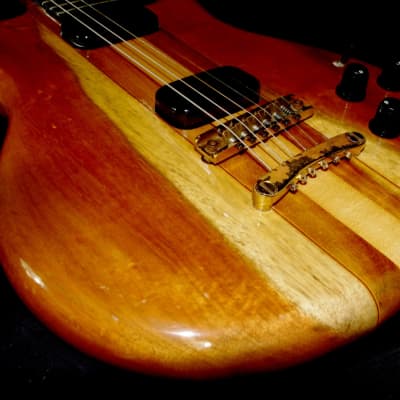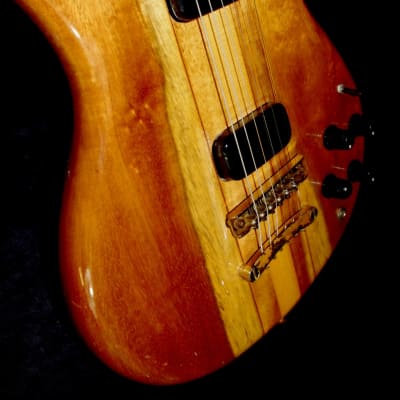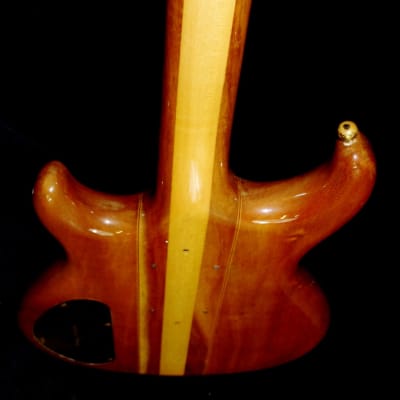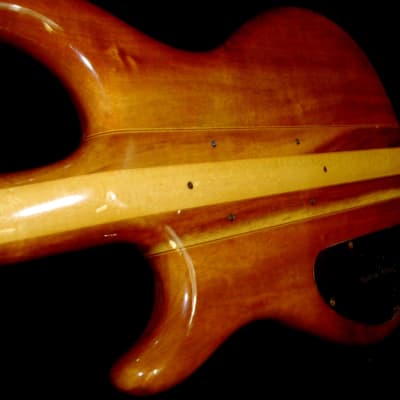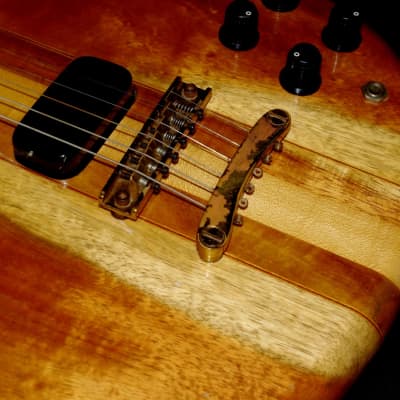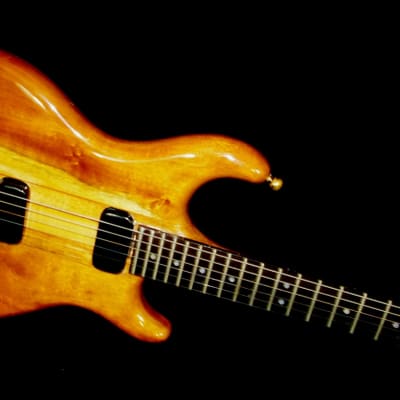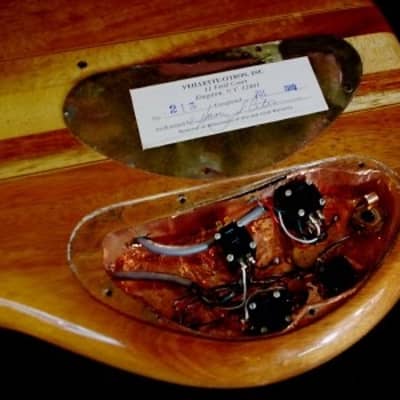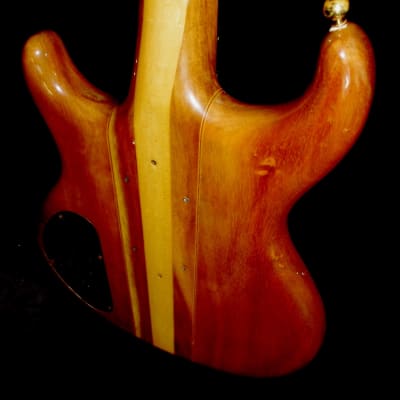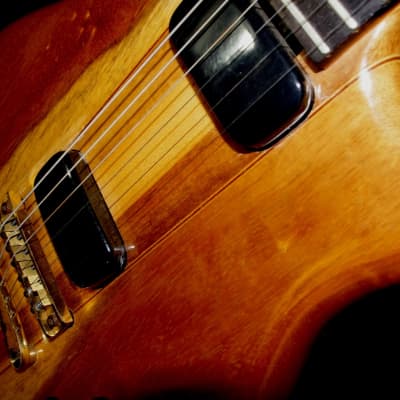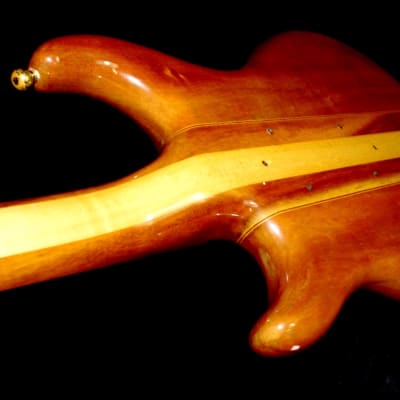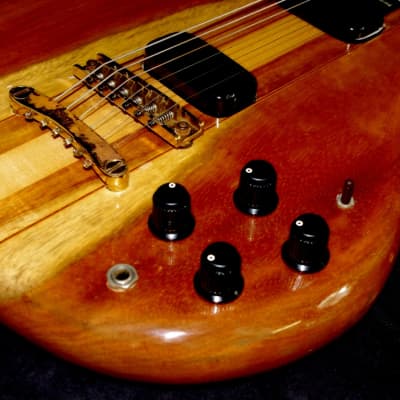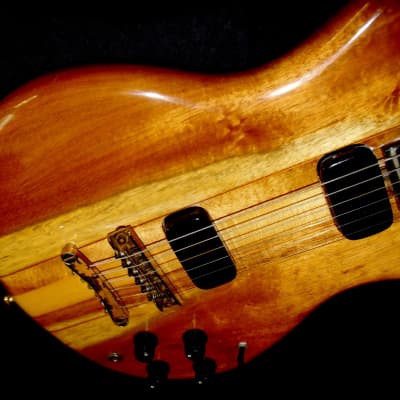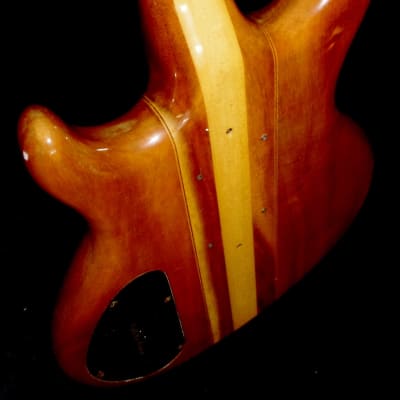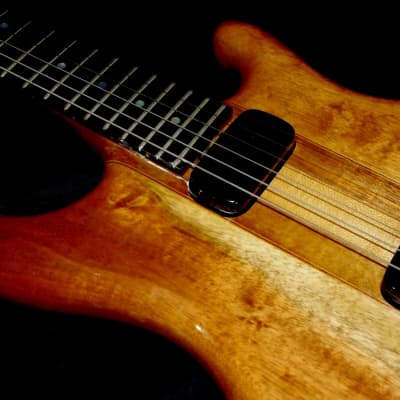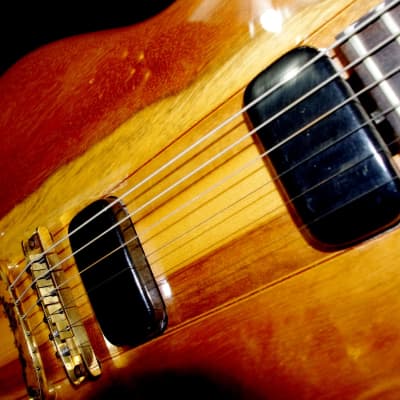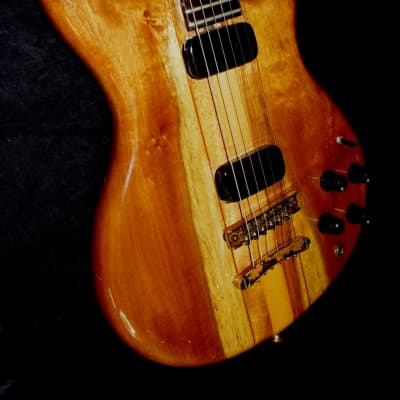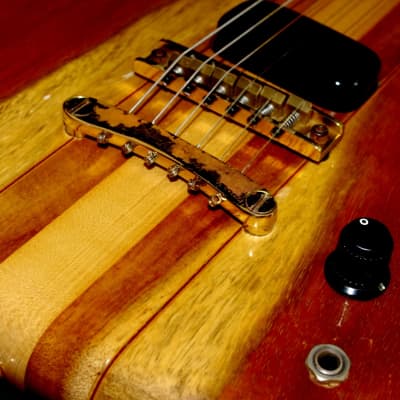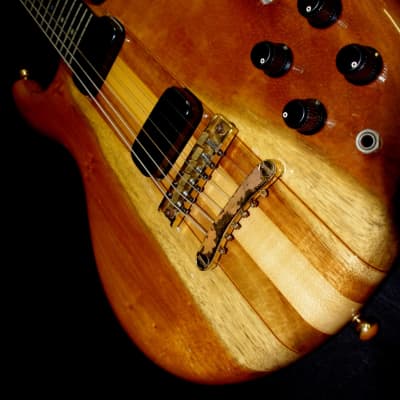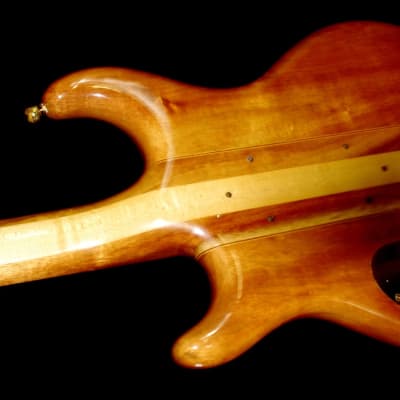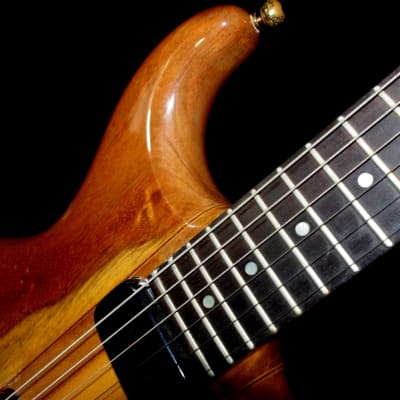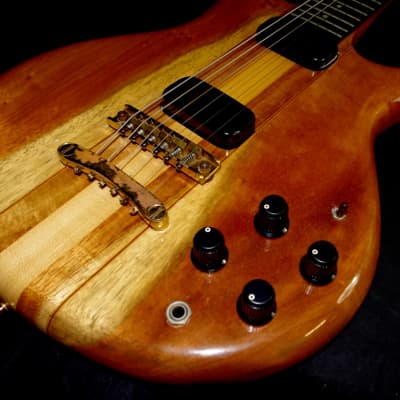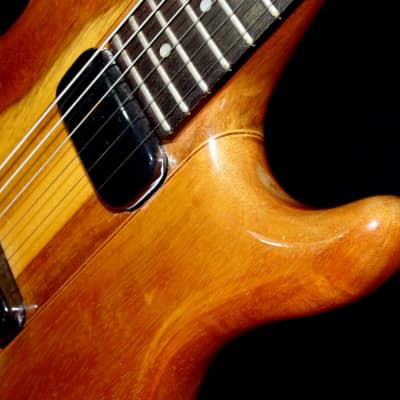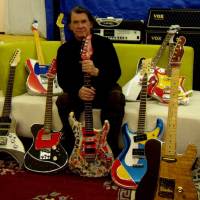Number One on my list of most undervalued "vintage custom" guitars.
VEILLETTE-CITRON
Model VC-CC "CLASSIC" GUITAR
1980
KOA.
EXTREMELY RARE!
STUNNING. ONE OF THE MOST BEAUTIFUL USES OF KOA WOOD FOR A GUITAR I HAVE EVER SEEN. AND LOTS OF IT.
My current collection of guitars and amplifiers now totals over 1500+ pieces. Within that collection are several brands of guitars that I consider to be unfairly ignored and undervalued as collectible instruments. Veillette-Citron (Guitars and Basses) is at the top of my list of these brands. They are absolutely superb instruments well-crafted with the best of materials by true artisans.
If you have not played a V-C, you have missed a marvelous experience. They are solid strong guitars with incredible tones coming from its custom pickups. And they are beautiful and stylish. The finishes are impeccable on the highly flamed maple woods (and rare exotic KOA wood).
I believe that Veillette Citron guitars, as well as those other incredible guitars built by Standel (Koontz), Lado, and others will soon attain the status of "collector guitars" and their increased value will be reflected in higher prices that they rightly deserve. The creation of the "collectible" guitar market initially came as the result of "word of mouth", magazine columns, and a lot of hype. The internet has now helped to bring needed attention to those luthiers who created guitars instead of just assembling or building them. Many of these luthiers must be considered as gifted artists and should be equally honored for their artistic skills as well as their resulting products. Also, with the buyer's ability to find a guitar online and buy it immediately, along with the seller's ability to immediately offer a guitar to millions of people throughout the world (thanks ebay), it does not take long for a demand trend (quite deserving in this case) to quickly outstrip the existing supply, e.g., Veillette Citron, as a company only built a total of 500 pieces and the majority of those were basses according to available information. In a "new" open world that honestly recognizes the inherent value of a handmade guitar as a piece of "performance art", i.e., it plays as good as it looks so every time it is played, it becomes a single piece art show as well. And even though I am guilty of buying many "new guitars" built by "new luthiers", I sometimes wonder if that is dishonoring those small shop luthiers who paved the way for these new builders to be able to gain access to a product market that was so dominated by the two major mass builders in the 1960's-70's as to make any attempt to introduce real "handbuilt" guitars into the market almost certainly doomed to fail. Veillette Citron did not fail. They succeeded in building one of a kind quality instruments that will become true "collectibles".
From online:
Sculptured Beauties
The Age of Veillette-Citron Guitars
by Baker Rorick. Guitar Shop, November 1997.
Veillette-Citron guitars are very rare birds today. Veillette-Citron was a pioneer in neck-thru-body construction with highly-figured maple and exotic hardwoods, sophisticated electronics, and other trend setting features, especially in modern, high-end electric bass design. They also created the first-ever production baritone guitars. Today, their hand crafted instruments are highly sought after by collectors, but lack of know ledge about this small company (many people think they're French) makes it possible to occasionally find over looked V-C's languishing in stores and pawn shops for only a few hundred dollars. Grab `em.
For star power, members of Orleans, Blondie, the Waitresses, and the B-52's played Veillette-Citron guitars and baritones, while Talking Heads' Tina Weymouth used a V-C bass, and Kasim Sultan (Utopia), Rutjer Gunnerson (ABBA), and Van Halen's Michael Anthony used their 8-string basses. Eddie Van Halen got a Shark baritone, and other V-C ban players include Jorma Kaukonen, Jeff "Skunk" Baxter, Devo's Robert Mothersbaugh, and James Taylor. Not a bad list of players, eh?
Veillette-Citron was founded in 1976 by Harvey Citron and Joe Veillette (pronounced "Vay-ette"), who met in architecture school. Citron had been playing guitar and performing since age 12, while Veillette had studied acoustic guitar building with luthier Michael Gurian. Eventually, both Joe and Harvey gave up their architecture careers to collaborate on guitars. They displayed a guitar and a bass in the Vinci Strings booth at Summer NAMM `76, and stunned the guitar community with the beauty and elegance of their designs. With a distribution agreement and orders in hand, they bought equipment and opened their own shop in Brooklyn. The first V-C catalog, from 1977, shows 6- and 12-string guitars, and a long-scale bass, all made of incredibly flamed maple, with laminated maple and ebony necks, ebony fingerboards, lacquered solid-brass and gold-plated hardware, deluxe Schaller tuning machines, and two "high clarity" humbucking pickups with coil taps, phase switches, individual Volume and Tone controls, and a Master Volume. Their basses had 24 jumbo frets, and the guitars had... 25! From the start, most of their instruments were custom-built and came with a variety of configurations and options, like 2- and 3-stage pickups, stereo wiring, and various body woods, including koa, walnut, or East Indian rosewood. Their 8-string bass became one of their most popular instruments. V-C evolved in friendly convergence as an East Coast equivalent of Alembic, with similarities in design and approach.
Where other companies moved to mass-production techniques to meet demand, Veillette-Citron emphasized craftsmanship, making each instrument a labor of love.
In 1979, v-c moved upstate to Kingston, NY, on the Hudson River not far from the Catskill mountain town of Woodstock. By 1980, V-C was making three series of instruments, most with just 22 frets: The Standard (black or sunburst finishes, basic electronics, rosewood finger-boards, chrome hardware), Classic (figured maple, two-stage pickups, ebony boards, gold hardware), and Limited Edition (exotic woods, deluxe electronics with 3-stage pickups, special carving and detailing). They had also tapped into the Woodstock music community, and, in conjunction with John Sebastian, V-C developed the first "Shark" baritone guitar, with a body shape similar to the Guild Thunderbirds that Sebastian and Zal Yanowsky had played in the Lovin' Spoonful. Harvey developed a new single-coil pickup for the Shark, and in 1982, V-C introduced their new S Series guitars, baritones, and one or two-pickup basses, with maple bodies and set-neck con struction, which retailed for under $1,000 (other V-Cs were priced from $1,250 to well over $2,000). Unfortunately, an expected infusion of capital for expanded production capability fell through, and increasing frustration with the business-end and daily grind led V-C to disband in 1983. They never had more than a half-dozen employees, and V-C's insistence on maintaining the integrity of their designs, quality, labor-intensive hardware and hand-wound pickups were not cost effective. Where other companies moved to mass-production techniques to meet demand, Veillette-Citron emphasized craftsmanship, making each instrument a labor of love. In all, Harvey and Joe built approximately 500 instruments in their seven-year run, about half of them basses, and including no more than 15 Shark baritones.
Earlier V-C instruments are distinguished by hand- tooled brass knobs and strap buttons, engraved brass control cavity backplates, and intricate details of workmanship too numerous to mention here, while later ones used commercially available endpins, plastic knobs, and plastic backplates. They continued throughout to fashion their own brass tailpieces and fully adjustable bridges. They're scarce today, and are more common on the East Coast and in the Midwest than out West.
ABOUT THIS GUITAR.
SN: 213
July, 1980
Signed by Harvey Citron
Ebony Fretboard.
Neck is laminated, quarter sawn, through body.
Tuners are gold Schallers.
Nut is brass.
Extensive electronic shielding to make guitar almost noise free.
Two stage pickups (2) fully adjustable. Dual coil. Noise cancelling.
Solid brass nut.
Solid brass bridge.
Solid brass tailpiece.
Volume control for each pickup has push-pull switch for staging pickups.
22 Frets.
OHSC.
This is one of the original V-C guitars with lots of brass. Signed by Harvey Citron.
